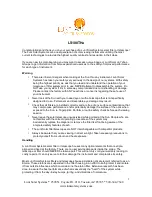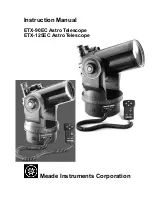
23
Figure 5-3
The emblem on the end of
the focus knob shows the
correct rotational direction
for focusing the NexStar
.
F
F
o
o
c
c
u
u
s
s
i
i
n
n
g
g
The NexStar's focusing mechanism controls the primary mirror which is mounted on a ring
that slides back and forth on the primary baffle tube. The focusing knob, which moves the
primary mirror, is on the rear cell of the telescope just below the star diagonal and eyepiece.
Turn the focusing knob until the image is sharp. If the knob will not turn, it has reached the
end of its travel on the focusing mechanism. Turn the knob in the opposite direction until
the image is sharp. Once an image is in focus, turn the knob clockwise to focus on a closer
object and counterclockwise for a more distant object. A single turn of the focusing knob
moves the primary mirror only slightly. Therefore, it will take many turns (about 25) to go
from close focus (approximately 20 feet) to infinity.
For astronomical viewing, out of focus star images are very diffuse, making them difficult to
see. If you turn the focus knob too quickly, you can go right through focus without seeing
the image. To avoid this problem, your first astronomical target should be a bright object
(like the Moon or a planet) so that the image is visible even when out of focus. Critical
focusing is best accomplished when the focusing knob is turned in such a manner that the
mirror moves against the pull of gravity. In doing so, any mirror shift is minimized. For
astronomical observing, both visually and photographically, this is done by turning the focus
knob counterclockwise.
C
C
a
a
l
l
c
c
u
u
l
l
a
a
t
t
i
i
n
n
g
g
M
M
a
a
g
g
n
n
i
i
f
f
i
i
c
c
a
a
t
t
i
i
o
o
n
n
You can change the power of your telescope just by changing the eyepiece (ocular). To determine the magnification of your
telescope, simply divide the focal length of the telescope by the focal length of the eyepiece used. In equation format, the
formula looks like this:
Focal Length of Telescope (mm)
Magnification =
Focal Length of Eyepiece (mm)
Let’s say, for example, you are using the 25mm eyepiece. To determine the magnification you simply divide the focal length of
your telescope (the NexStar has a focal length of 1300mm) by the focal length of the eyepiece, 25mm. Dividing 1300 by 25
yields a magnification of 52 power.
Although the power is variable, each instrument under average skies has a limit to the highest useful magnification. The general
rule is that 60 power can be used for every inch of aperture. For example, the NexStar is 4" in diameter. Multiplying 4 by 60
gives a maximum useful magnification of 240 power. Although this is the maximum useful magnification, most observing is
done in the range of 20 to 35 power for every inch of aperture which is 80 to 140 times for the NexStar telescope.
D
D
e
e
t
t
e
e
r
r
m
m
i
i
n
n
i
i
n
n
g
g
F
F
i
i
e
e
l
l
d
d
o
o
f
f
V
V
i
i
e
e
w
w
Determining the field of view is important if you want to get an idea of the angular size of the object you are observing. To
calculate the actual field of view, divide the apparent field of the eyepiece (supplied by the eyepiece manufacturer) by the
magnification. In equation format, the formula looks like this:
Apparent Field of Eyepiece
True Field =
Magnification
As you can see, before determining the field of view, you must calculate the magnification. Using the example in the previous
section, we can determine the field of view using the same 25mm eyepiece. The 25mm eyepiece has an apparent field of view of
52°. Divide the 52° by the magnification, which is 52 power. This yields an actual field of view of 1.0°.
To convert degrees to feet at 1,000 yards, which is more useful for terrestrial observing, simply multiply by 52.5. Continuing
with our example, multiply the angular field 1.0° by 52.5. This produces a linear field width of 52.5 feet at a distance of one
thousand yards. The apparent field of each eyepiece that Celestron manufactures is found in the Celestron Accessory Catalog
(#93685).
Summary of Contents for NEXSTAR 4
Page 1: ...I IN NS ST TR RU UC CT TI IO ON N M MA AN NU UA AL L ...
Page 41: ...41 A Ap pp pe en nd di ix x C C M Ma ap ps s o of f T Ti im me e Z Zo on ne es s ...
Page 42: ...42 ...
Page 43: ...43 ...
Page 44: ...44 ...
Page 45: ...45 ...
Page 46: ...46 ...
Page 47: ...47 ...
Page 48: ...48 ...













































